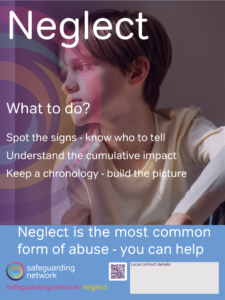Introduction
Statistics compiled by the NSPCC suggest that almost half of all children on child protection plans in England are on plans because of concerns about neglect, and that 1-in-10 children will have experienced neglect – i.e., potentially 3 children in every class of 30. In 2021/2022, Childline referred 8,389 children to agencies regarding concerns of neglect.
We often intervene too slowly with neglect, sometimes because no single incident acts as a trigger, with concerns usually building up over time. At other times, referrals are made to other agencies and perhaps are not taken sufficiently seriously.
The latest annual report from the Safeguarding Practice Review Panel found in 53% of cases reviewed children had suffered neglect prior to the incident of abuse. We need to understand the cumulative effects of neglect and actively review the concerns to assess the level of harm caused.
Need more?
Thank you for visiting our resources pages. These are free to everyone as is our fortnightly safeguarding bulletin – general safeguarding information is too important to restrict. Become a member to access lots more, including training materials for you to deliver in-house on each topic in Keeping Children Safe in Education.
Sign up for FREE fortnightly bulletin.
What about training?
We can deliver training for your setting on this and other subjects via online platforms, or face-to-face in certain areas. Just get in touch to discuss your requirements.
Definition of neglect
Neglect is the persistent failure to meet a child’s basic physical and/or psychological needs, likely to result in the serious impairment of the child’s health or development.
Types of neglect
Neglect can include:
- educational – not ensuring the child receives/attends appropriate education.
- physical – failure to provide for basic needs e.g., food, shelter, safety (including exclusion from home or abandonment) and/or failing to provide adequate supervision (including the use of inadequate carers). Physical neglect may also occur during pregnancy as a result of maternal substance misuse.
- emotional – failure to nurture, protect from emotional harm and/or provide the stimulation a child needs. This overlaps with emotional abuse and may involve ignoring, intimidating, isolating or humiliating the child.
- medical – a failure to ensure a child receives appropriate medical care and treatment, including dental care, or ignoring medical advice. It includes the failure of the parent/carer to take their child to appointments.
- adolescent – the failure to provide adequate parenting and support for teenagers resulting in them being left to deal with issues by themselves (e.g., sourcing clothing and food, finding shelter, dealing with emotions, levels of supervision and general well-being).
A common form of abuse
The NSPCC reports that recorded offences of adults neglecting, mistreating, or assaulting children have doubled over the last 5 years.
Neglect can have a serious and long-term impact on the child. Children who suffer neglect may also suffer from other forms of abuse as well.
"I can’t stop crying and I don’t know who to talk to about this. My mum isn’t looking after me properly. She never has any money, there is never food in the house, and she doesn’t take me to school. She takes drugs a lot and always asks me for money to get more. After she’s taken drugs, she’s in a really bad mood and is mean to me."
However, neglect is one of the most difficult forms of abuse to recognise because there is often no single standout indicator and so professionals may wait for a pattern of neglect to build up over time. Maintaining a chronology of concerns and understanding the cumulative impact of several different indicators is therefore key.
External factors
Sometimes neglect occurs because parents/carers won’t look after their children and sometimes because they are unable to. Covid-19 led to significant strains within families, often linked to financial and job security. Many families endured difficult situations involving poverty and homelessness. The cost-of-living crisis has made this worse, with parents unable to provide the essentials such as food and heating. Many parents and carers feel the need to work longer hours, leaving children with inadequate supervision because they cannot afford additional or suitable childcare. Concerns about providing for children have also led to increases in parental mental ill health and parental substance misuse.
Whilst families may not be deliberately neglecting the needs of their children, intervention is still necessary to prevent either short-term or long-term harm.
Spot the signs
Physical indicators of neglect:
- constant hunger;
- poor personal hygiene;
- poor dental health;
- skin rashes, lice etc.;
- constant tiredness;
- inadequate and/or dirty ill-fitting clothing;
- untreated medical problems;
- under/overweight.
Behavioural indicators of neglect:
- social isolation;
- poor self-esteem;
- frequent lateness or missing education;
- missed medical /dental appointments;
- destructive tendencies;
- poor relationships with peers;
- compulsive stealing/scavenging.
Additional vulnerabilities
Any child can suffer from neglect, but some groups of children may be more vulnerable, such as those:
- with parents/carers out of the house for prolonged periods;
- living in poverty;
- with parents/carers experiencing substance/alcohol misuse issues;
- with parents/carers experiencing mental health issues or with disabilities;
- with disabilities;
- being left on their own for prolonged periods or being left in the care of siblings or unsuitable carers.
Whether they fit any of the criteria on this list or not, if you have concerns about a child speak to your DSL.
Children left home alone
The NSPCC note that there have been rising reports of children being left home alone over the school holidays. Whilst there is no minimum age when a child can be left on their own, it is “an offence to leave a child alone if it places them at risk” – there are expectations about the child being mature enough to be able to deal with problems that may arise.
What to do
Consider how vulnerabilities might impact on individuals – Talk to children in advance about holiday periods and assess the risks of ‘holiday hunger’, loneliness and neglect. Think about the increased risk of exploitation and the barriers in place to attainment or to making safe decisions. Recognise the stresses around key times of year, such as the commercial pressures around Christmas.
Check young people have safe relationships – in their family, with their peers and with your staff. Create the environment where it is okay to talk, even about the most difficult things.
Know the signs and know what to do – use the checklists above, your safeguarding procedures and be confident to raise neglect as a possibility.
Keep a chronology – neglect is not necessarily about one event but an accumulation of several different concerns and observations. It's important that these are noted at the time to allow the building of a bigger picture of the experiences of the child or young person.
Promote safeguarding
Education settings are key to enabling the provision of early help and empowering parents to care for their families.
This could include:
- promoting positive relationships with parents and carers that encourage them to learn and understand what support they need, and to seek help when problems first appear;
- providing direct practical and emotional support to a child and/or their parents/carers;
- knowing which services are available and offer appropriate support to families, and signposting families to them when necessary;
- recognising when children need protection and sharing essential information about a child and their family with relevant agencies as necessary;
- monitoring a child’s situation and checking in regularly so they know they have ongoing support.
Take action – and keep taking action until you know children and young people are safe.
Free neglect poster
This free, downloadable resource raises the profile of safeguarding for your staff team. For use in staff rooms, on safeguarding boards or on the back of toilet doors, the poster includes tips, a space for local contact details, plus a link and QR codes to this resource page. Download the poster from the resources below.
DSL Training Materials
-

Presentation
-

Presenter Notes
-

Handout for staff
-

Neglect – Quiz
-

Neglect – Quiz (Answer Sheet)
-

Neglect scenario – Early Years Settings
-

Neglect scenario (Early Years settings) – DSL Information sheet
-

Neglect scenario – Primary schools
-

Neglect scenario (Primary Schools) – DSL Information sheet
-

Neglect scenario – Secondary schools
-

Neglect Scenario (Secondary Schools) – DSL information sheet
-

Neglect scenario - 16+ Settings
-

Neglect scenario (FE settings) - DSL Information sheet
-

Neglect scenario – SEND focus
-

Neglect scenario (SEND focus) – DSL Information sheet
-

Neglect scenario - Care settings
-

Neglect Scenario (Care) – DSL Information Sheet
Resources
-

Neglect poster
-

Growing up neglected: a multi-agency response to older children
-

Neglect in affluent families
-

Nuffield Foundation – Protecting young children at risk of abuse and neglect
-

Neglect: learning from case reviews
-

The GCP2 assessment tool for neglect
-

Child neglect podcasts
-

Child abuse and neglect
Save time and improve your safeguarding approach…
Bite-size training materials to share with your staff every month.
Support to explore and develop your safeguarding culture.
A huge array of resources and professional experience at your fingertips.
Get in touch now for a personal tour of the site and details of membership benefits.
We look forward to working with you.


